Predicting academic performance of medical students - ResearchGate
Predicting academic performance of medical students - ResearchGate
Predicting academic performance of medical students - ResearchGate
You also want an ePaper? Increase the reach of your titles
YUMPU automatically turns print PDFs into web optimized ePapers that Google loves.
Word count: 4018<br />
Number <strong>of</strong> tables: 5<br />
Title:<br />
<strong>Predicting</strong> <strong>academic</strong> <strong>performance</strong> <strong>of</strong> <strong>medical</strong> <strong>students</strong>: the first three years.<br />
Authors:<br />
Cyril Höschl, M. D., DrSc., Jiří Kožený, Ph.D.<br />
From:<br />
3 rd Medical Faculty, Charles University, Prague and Psychiatric Center Prague<br />
Address reprint requests to:<br />
Dr. Cyril Höschl, 3rd Medical Faculty, Charles University, Ruská 87, 100 00<br />
Prague 10, Czech Republic<br />
Acknowledgment:<br />
Supported by the Internal Grant Agency <strong>of</strong> the Czech Ministry <strong>of</strong> Health grant<br />
No. 1407-8.<br />
1
Objectives: The purpose <strong>of</strong> this exploratory study was to identify a cluster <strong>of</strong><br />
variables that would most economically explain variation in the grade point<br />
average <strong>of</strong> <strong>medical</strong> <strong>students</strong> during the first three years <strong>of</strong> study. Method: Data<br />
were derived from a study <strong>of</strong> 92 <strong>students</strong> admitted to the 3rd Faculty <strong>of</strong><br />
Medicine in 1992/93 <strong>academic</strong> year on the basis <strong>of</strong> entrance examination and<br />
were still in the <strong>medical</strong> school at the end <strong>of</strong> the sixth semester. Stepwise<br />
regression analysis was used to build models for predicting log-transformed<br />
grade point average change after six semesters <strong>of</strong> study, at the end <strong>of</strong> the first,<br />
second, and the third year. Predictor variables were chosen from the four<br />
domains: a) high school grade point average in physics, mathematics, and<br />
Czech language over four years <strong>of</strong> study, b) admission tests in biology,<br />
chemistry, and physics, c) admission committee assessment <strong>of</strong> applicants<br />
ability to reproduce a text, motivation to study medicine, and social maturity, d)<br />
Tridimensional Personality Questionnaire Sentimentality and Dependence<br />
scale scores. Results: Regression model, which included high school physics,<br />
admission test in physics, applicants motivation, and Sentimentality scale,<br />
accounted for 32% <strong>of</strong> the grade point average change over six semesters <strong>of</strong><br />
study. The regression models using the first, second and third year grade point<br />
average as the dependent variables showed slightly decreasing amount <strong>of</strong><br />
explained variance toward the end <strong>of</strong> the third year <strong>of</strong> study and within domains<br />
changing structure <strong>of</strong> predictor variables. Conclusions: The results suggest that<br />
variables chosen from high school, written entrance examination, admission<br />
interview and personality traits assessment domains may be significant<br />
predictors <strong>of</strong> <strong>academic</strong> success during the first three years <strong>of</strong> study.<br />
2
The first author used to meet Melvin Sabshin from time to time on the<br />
occasion <strong>of</strong> common meetings <strong>of</strong> the WPA Executive Committee and Standing<br />
Committee on Long Range Planning. In 1995, Melvin Sabshin came to Prague<br />
to attend a regional WPA meeting. We learned from him that questions and<br />
challenges in <strong>medical</strong> education represent important objectives <strong>of</strong> our effort<br />
both in psychiatry and in medicine as a whole. Mel was active not only as a<br />
chairperson <strong>of</strong> Continuing Medical Education Committee <strong>of</strong> WPA (1983), but<br />
also as an author <strong>of</strong> papers focused on <strong>students</strong>' behavior (17) and education<br />
(11, 14, 15). His enthusiasm contributed to our fascination with the process <strong>of</strong><br />
<strong>medical</strong> education and with people who have chosen <strong>medical</strong> careers. Soon<br />
after the breakdown <strong>of</strong> communism in our country we recognized the necessity<br />
<strong>of</strong> a deep transformation <strong>of</strong> our health-care and educational systems. As our<br />
entrance examinations to the university appeared ambiguous, we launched a<br />
longitudinal study on predictors <strong>of</strong> <strong>academic</strong> <strong>performance</strong> <strong>of</strong> <strong>medical</strong> <strong>students</strong><br />
(8, 9, 10).<br />
The decision to accept a student into <strong>medical</strong> program presents a major<br />
problem for all members <strong>of</strong> a <strong>medical</strong> school community. The admission<br />
decision affects both the <strong>students</strong> and the institution, given that the quality <strong>of</strong><br />
<strong>students</strong> influences the school´s reputation and vice versa. The selection <strong>of</strong><br />
admission criteria is a problem which has not been successfully solved until<br />
now. The qualifications <strong>of</strong> an applicant include qualitative and quantitative<br />
variables. A different structure <strong>of</strong> a <strong>students</strong>´ attributes is probably required to<br />
succeed at different stages <strong>of</strong> the study.<br />
In the search <strong>of</strong> predictors <strong>of</strong> <strong>academic</strong> <strong>performance</strong> during the past 20 years<br />
considerable effort has been devoted to finding indicators <strong>of</strong> the applicant´s<br />
potential using cognitive abilities, high school grades, personality traits, letters<br />
<strong>of</strong> reference and socio-economic data. The <strong>academic</strong> success has been<br />
operationalized in most cases as a grade point average. Correlation matrices<br />
were, with few exceptions (13), analyzed using linear regression and criterion<br />
variance explained by regressors never, to our knowledge, exceeded 19% (1,<br />
5, 6, 15). Failure to account for the greater part <strong>of</strong> the difference in <strong>academic</strong><br />
success among <strong>students</strong> indicates that focusing on the improvement <strong>of</strong> tuition<br />
3
methods might be more effective approach to the problem solution then trying<br />
in vain to construct prognostic instruments (19).<br />
However, the admission policies, procedures and capacity <strong>of</strong> <strong>medical</strong> schools<br />
have not changed as rapidly as the number <strong>of</strong> applicants and they show much<br />
wider diversity both in their preparation and hierarchy <strong>of</strong> values. Besides,<br />
<strong>medical</strong> schools reflecting the changing demands <strong>of</strong> society activate new<br />
programs and curricula requiring cognitive flexibility and ability to process<br />
information creatively rather than mechanical memory which is frequently the<br />
main admission criterion (11).<br />
The present day <strong>medical</strong> schools are preparing physicians for the next<br />
millennium under the strong pressure <strong>of</strong> a marked increase in the number <strong>of</strong><br />
applicants, the government curbing it rising costs, and the society demands. It<br />
is obvious that the modification <strong>of</strong> admission criteria based on a careful<br />
analysis <strong>of</strong> available data is advisable, and is still not entirely rational to<br />
abandon nomothetic approach because so far only few stable correlation<br />
patterns appeared.<br />
Our study was undertaken 1) to identify variables chosen from the pre<strong>medical</strong><br />
education grades, admission procedure, and personality structure domains<br />
with predictive validity for <strong>academic</strong> success over three years <strong>of</strong> study, 2) to<br />
determine whether there were differences in structure and predictive validity <strong>of</strong><br />
those variables for each <strong>of</strong> the subsequent years during the first three years <strong>of</strong><br />
study.<br />
METHODS<br />
Subjects<br />
The subjects were 92 <strong>students</strong> (40 females, mean age 18.2, SD = 0.7; 52<br />
males, mean age 18.5, SD = 1.3) admitted to the 3rd Faculty <strong>of</strong> Medicine in<br />
1992/93 <strong>academic</strong> year on the basis <strong>of</strong> entrance examination and were still in<br />
the <strong>medical</strong> school at the end <strong>of</strong> the sixth semester.<br />
Measures<br />
On the basis <strong>of</strong> previous studies (8, 9, 10) suggesting the possible predictive<br />
utility <strong>of</strong> the university <strong>academic</strong> achievement the independent measures were<br />
4
chosen from four domains: a) high school: the arithmetic average <strong>of</strong> the<br />
courses taken in math, physics, and Czech language (five-point scale; 1<br />
excellent - 5 insufficient) over the course <strong>of</strong> four years, b) written entrance<br />
examination: 30 four-choice question tests on physics, biology, and chemistry,<br />
c) admission interview: committee assessment <strong>of</strong> applicants´ <strong>performance</strong><br />
during an interview which consisted <strong>of</strong> the evaluation <strong>of</strong> text reproduction from<br />
the point <strong>of</strong> view <strong>of</strong> information density, the estimation <strong>of</strong> her/his motivation to<br />
study medicine and his/her social maturity (5-point scale; 5 excellent - 1<br />
insufficient), d) personality traits assessment: Tridimensional Personality<br />
Questionnaire (2, 3) Reward Dependence scale RD1 Sentimentality - Tough<br />
Mindedness (high scores: sympathetic, understanding individuals who tend to<br />
be deeply moved by sentimental appeals and experience vicarious emotion<br />
intensely; low scorers: practical, tough minded, coolly detached, insensitive to<br />
the feelings <strong>of</strong> other people, unable to establish social rapport), and RD3 scale<br />
Attachment - Detachment ( high scores: prefer intimacy over privacy, tend to<br />
form lasting social attachments and are sensitive to rejection and slights; low<br />
scorers: manifest pronounced detachment and disinterest in social<br />
relationships, they impress others as self contained, alienated, detached and<br />
indifferent to rejection and slights). The psychometric integrity <strong>of</strong> the TPQ<br />
Czech version is reported elsewhere (7). The entrance examination in 1992<br />
was experimental and applicants were informed that only their <strong>performance</strong> on<br />
the tests <strong>of</strong> physics, biology and chemistry but not psychological tests, would<br />
be considered as the admittance criterion.<br />
The dependent variables were the first year grade point average (GPA1)<br />
based on the courses in biophysics, <strong>medical</strong> chemistry, biology, anatomy, first<br />
aid, Latin; the second year grade point average (GPA2) based on courses in<br />
histology, biochemistry, physiology; the third year grade point average (GPA3)<br />
based on courses in microbiology, immunology, molecular biology, pathology,<br />
pathological physiology, psychology, introduction to clinical praxis, and the total<br />
grade point average (GPA) based on the three years´ study examination<br />
results. All values were adjusted for the number <strong>of</strong> examination failures. An<br />
examination has been traditionally oral, evaluated on 4-point scale (1 excellent<br />
- 4 insufficient), and <strong>students</strong> are entitled to three attempts). Since the subjects<br />
5
were not expected to fail all examinations and thus the distributions <strong>of</strong> the<br />
dependent variables were inherently highly positively skewed (range 1.18 -<br />
1.31) the data were subjected to natural logarithmic transformation (range <strong>of</strong><br />
skewness after transformation for dependent variables 0.35 - 0.29). The<br />
distribution <strong>of</strong> the transformed criteria were tested using Lilliefors modification<br />
<strong>of</strong> Kolmogorov-Smirnov test <strong>of</strong> normality; GPA1 (K-S=0.11, df=92, p = 0,008),<br />
GPA2 (K-S=0.12, df=92, p = 0,002, GPA3 (K-S=0.101, df=92, p = 0,2), GPA<br />
(K-S=0.076, df=92, p = 0,2). Apart from GPA the distributions <strong>of</strong> the dependent<br />
variables were still statistically different from normal distribution after<br />
transformation. However, in normal probability plots the points clustered<br />
reasonably well around a straight line and so we presume that the data are<br />
sufficiently normally distributed.<br />
Statistical analysis<br />
We examined relationships among all variables included into the analysis<br />
using correlation coefficients. Linear regression by groups was used to test<br />
equality <strong>of</strong> regression models for females and males. We used multiple and<br />
one factor analyses <strong>of</strong> variance to compare gender differences on dependent<br />
and independent variables. Stepwise multiple linear regression analyses<br />
(criterion: probability F-to-enter ≥ 0,05, F-to-remove ≤ 0,051) were used to<br />
assess the predictive value <strong>of</strong> the independent variables. As stepwise method<br />
tends to capitalize on sampling error that is unique to the given sample and the<br />
method may yield conclusions that will not replicate (18), we reanalyzed the<br />
data using all possible subsets regression approach and observed no<br />
differences between the stepwise and the estimated "best" subsets <strong>of</strong> predictor<br />
variables regression equations. Collinearity and influence diagnostics were<br />
performed on all regression equations, and multicollinearity and extreme outlier<br />
effects were ruled out. Data were analyzed with the Statistical Package for the<br />
Social Sciences (12) and BMDP Statistical S<strong>of</strong>tware (4).<br />
6
RESULTS<br />
The test <strong>of</strong> equality <strong>of</strong> regression equations over gender groups yielded<br />
statistically insignificant F ratio for all measures <strong>of</strong> <strong>academic</strong> success (GPA:<br />
F=0.89, df = 12, 68, p= 0.56; GPA1: F = 1.03, df = 12, 68, p= 0.43; GPA2:<br />
F=0.93, df = 12, 68, p= 0.52; GPA3: F=0.75, df = 12, 68, p= 0.70) thus we<br />
assumed that the regression coefficients for males and females were identical.<br />
In addition, we observed the effect <strong>of</strong> gender neither on the GPA1, GPA2,<br />
GPA3 (MANOVA, Wilks´ λ =0,98, df = 3, 87, p = 0,76), and on the GPA<br />
(ANOVA, F=0.53, df = 1, 91, p=0,46) nor on eleven independent variables<br />
(MANOVA, Wilks´ λ =0,83, df = 11, 80, p=0,18) and did not used gender as a<br />
classification variable.<br />
The correlation matrix (Tab. 1) indicates statistically significant relations<br />
among GPA1, GPA2, and GPA3 suggesting that the <strong>academic</strong> success<br />
measures had on the average 47% <strong>of</strong> the variance in common. Apart from the<br />
results <strong>of</strong> the entrance examination in chemistry and biology we found a<br />
statistically significant correlation between all predictors and the GPA and, with<br />
two exceptions, the GPA1, and GPA3 measures. The interview variables<br />
correlated insignificantly with the GPA2. The predictors within the high school<br />
and admission interview domains were closely associated. Across domains<br />
we observed a statistically significant correlation pattern between the high<br />
school and written entrance examination variables.<br />
The entrance examination results in biology and chemistry, the admission<br />
committee assessment <strong>of</strong> applicants´ social maturity, and the high school<br />
grade point average in Czech language variables did not enter into any<br />
regression equation.<br />
The multiple linear regression full mode accounted for 32% <strong>of</strong> the variance in<br />
GPA (Tab. 2). The semipartial correlation coefficients indicated comparable<br />
incremental validity for all predictors included into model by the stepwise<br />
method. Nonetheless, the most important was the contribution from the first two<br />
predictors. Together, these two variables had only 7% <strong>of</strong> variance in common<br />
and accounted for 21% <strong>of</strong> the total explanatory power <strong>of</strong> the equation.<br />
7
The regression models using GPA1, GPA2, GPA3 as the dependent<br />
variables showed a different structure <strong>of</strong> predictor variables and slightly<br />
decreasing amount <strong>of</strong> explained variance toward the end <strong>of</strong> the third year <strong>of</strong><br />
study (Tab. 3, 4, 5). Only high school grade point average in physics had the<br />
statistically significant regression coefficients in all models and a similar<br />
incremental validity. In predicting GPA2 changes high school grade point<br />
average in physics was substituted by high school grade point average in<br />
mathematics. Admission committee assessment <strong>of</strong> applicants´ motivation was<br />
included only in the model explicating the GPA3 variation. In the model<br />
explaining GPA1 variation the text reproduction variable became the substitute<br />
<strong>of</strong> applicants´ motivation estimation, and RD3 Attachments scale variable was<br />
replaced by RD1 Sentimentality scores. Apart from the regression model<br />
estimating GPA2 variation where we did not observe variables from the<br />
interview domain the changes in regressor structures <strong>of</strong> all models were within<br />
particular domains indicating probably the influence <strong>of</strong> masking effect.<br />
DISCUSSION<br />
The changes in the predictor structures during the course <strong>of</strong> three years,<br />
which were always within the particular domain might be probably explained as<br />
a random error variation considering that examinations were oral and the<br />
<strong>students</strong> achievement in a particular subject was estimated frequently by<br />
different examiners. Besides, as the correlation coefficients in Tab. 1<br />
suggested, admission committees probably found it difficult to differentiate<br />
among the text evaluation, motivation to study medicine, and social maturity<br />
assessments. In addition, the content <strong>of</strong> written entrance examination in<br />
physics, intended to compensate for differences in high schools educational<br />
level, more or less corresponded to the high school curriculum. The semipartial<br />
correlation coefficients indicated that the incremental validity <strong>of</strong> predictors from<br />
cognitive domains tended to decrease toward the end <strong>of</strong> the third year in<br />
comparison to the predictors from the personality trait and self-presentation<br />
interview domain. This finding suggest that personality dispositions might<br />
compensate for mental ability deficiencies in achieving <strong>academic</strong>al success.<br />
8
The inclusion <strong>of</strong> the text reproduction variable into the regression equation<br />
estimating GPA1 changes probably reflected the exclusively theoretical content<br />
<strong>of</strong> the first year courses where success depended substantially on information<br />
retention and reproduction. The GPA2 was based only on the results from<br />
three examinations in subjects where logical information processing skill rather<br />
than mechanical memory was decisive for success. No variable from the<br />
interview domain was entered into the model where cognitive ability variables<br />
accounted for 20% <strong>of</strong> the model´s 26% explanatory power. Most <strong>of</strong> the third<br />
year seven examinations are considered very demanding and each requires<br />
different mental skills including the potential to absorb emotional load stemming<br />
from personal contact with patients, which was reflected in the reduced<br />
differences between cognitive and personality characteristic incremental<br />
validity.<br />
CONCLUSION<br />
The results suggest that variables chosen from high school, written entrance<br />
examination, admission interview, and personality traits assessment domains<br />
may be significant predictors <strong>of</strong> <strong>academic</strong> success during the first three years<br />
<strong>of</strong> study. It appeared that cognitive potential represented in this study by the<br />
ability to solve problems based on a skill to apply physical and mathematical<br />
axioms, plausibly manifested strong motivation to become a member <strong>of</strong><br />
<strong>medical</strong> community, and independence from sentimental considerations which<br />
leads to practical and objective views might be associated with <strong>academic</strong><br />
<strong>performance</strong> at the first half <strong>of</strong> study when contact with patients, especially<br />
during the first two years, is still limited and theoretical knowledge processing<br />
constitutes the main criterion for <strong>students</strong> <strong>performance</strong> evaluation.<br />
Although the variance explained by the models is considerable in comparison<br />
to the previous studies and the predictors structure relatively stable over the six<br />
semesters, it is apparent that the regression analysis results which are<br />
necessarily limited to the particular kind <strong>of</strong> study group, do not contribute<br />
substantially to the estimation <strong>of</strong> student risk <strong>of</strong> <strong>academic</strong> failure. Admission<br />
committees are interested in predicting probability <strong>of</strong> success or failure rather<br />
then estimation <strong>of</strong> grade point average which has the prevailingly theoretical,<br />
9
illustrative significance only. In the future research using categorical approach<br />
may produce more applicable information.<br />
10
REFERENCES<br />
1. Abedi J: <strong>Predicting</strong> graduate <strong>academic</strong> success from undergraduate<br />
<strong>academic</strong> <strong>performance</strong>: A canonical correlation study, Educational and<br />
Psychological Measurement, 1991; 51:151-160<br />
2. Cloninger CR: A systematic method for clinical description and classification<br />
<strong>of</strong> personality variants, Archives <strong>of</strong> General Psychiatry, 1987; 44:573-588<br />
3. Cloninger CR: The Tridimensional Personality Questionnaire, 1987; Version<br />
IV., St. Louis, MO: Washington University School <strong>of</strong> Medicine<br />
4. Dixon WJ (ed.): BMDP Statistical S<strong>of</strong>tware Manual, release 7.0, University<br />
<strong>of</strong> California Press, Berkeley, 1995.<br />
5. Fisher JB, Resnik DA: Standardized testing and graduate and pr<strong>of</strong>essional<br />
school grades in six fields, College and University, 1990; 55:765-769<br />
6. Graham LD: <strong>Predicting</strong> <strong>academic</strong> success <strong>of</strong> <strong>students</strong> in a master <strong>of</strong><br />
business administration program, Educational and Psychological<br />
Measurement, 1991; 51:721-727<br />
7. Kozeny J, Kubicka L, Prochazkova Z: Psychometric Properties <strong>of</strong> the Czech<br />
Version <strong>of</strong> Cloninger´s Tridimensional Personality Questionnaire, Person.<br />
individ. Diff., 1989; 10:1253-1259<br />
8. Kozeny J, Tisanska L: Personality pr<strong>of</strong>ile <strong>of</strong> the <strong>students</strong> accepted at the 3rd<br />
faculty <strong>of</strong> medicine UK Prague in 1992/93, Československá psychologie,<br />
1995; 39:358-364<br />
9. Kozeny J, Klaschka J: <strong>Predicting</strong> first-year grade point average for <strong>students</strong><br />
in <strong>medical</strong> faculty, Ceskoslovenska psychologie, 1995; 39:601-609<br />
10. Kozeny J, Höschl C: Structural model <strong>of</strong> <strong>medical</strong> <strong>students</strong> <strong>academic</strong><br />
<strong>performance</strong> after the first four semesters, Ceskoslovenska psychologie,<br />
1996; 40:177-184<br />
11. Levit EJ, Sabshin M, Mueller CB: Trends in graduate <strong>medical</strong> education<br />
and specialty certification: a tracking study <strong>of</strong> United States <strong>medical</strong> schools<br />
graduates, N Engl J Med, 1974; 290 (10): 545-549.<br />
12. Norusic, MJ: SPSS for Windows: Base System User´s Guide, Release 7.0,<br />
Chicago, SPSS, 1996<br />
11
13. Remus W, Wong C: An evaluation <strong>of</strong> five models for the admission<br />
decision, College Student Journal, 1982;16:53-59<br />
14. Sabshin M: Some comments about the internship, Journal <strong>of</strong> Psychiatric<br />
Education, 1977; 1: 29-32.<br />
15. Sabshin M: The integration <strong>of</strong> education and service, Journal <strong>of</strong> Psychiatric<br />
Education. 1980; 4: 254-259.<br />
16. Sobol MG: GPA, GMAT, and SCALE: A method for quantification <strong>of</strong><br />
admissions criteria, Research in Higher Education, 1984; 20:77-88<br />
17. Sabshin M. et al: Student protests: a phenomenon for behavioral sciences<br />
research. Statement <strong>of</strong> a group <strong>of</strong> Fellows at the Center for Advanced Study<br />
in the Behavioral Sciences, Stanford, California, Science, 1968;<br />
161/836:20-23.<br />
18. Thompson, B: Stepwise Regression and Stepwise discriminant analysis<br />
need not apply here: a guidelines editorial, Educational and Psychological<br />
Measurement, 1995; 4, 55: 525-531<br />
19. Wilson RL, Hardgrave BC: <strong>Predicting</strong> graduate student success in an MIBA<br />
program: Regression versus classification, Educational and Psychological<br />
Measurement, 1995; 55:186-195<br />
12
Tab. 1 Correlation coefficients <strong>of</strong> variables analyzed in the study.<br />
variable 1. 2. 3. 4. 5. 6. 7. 8. 9. 10. 11. 12. 13. 14.<br />
3. - .66*<br />
4. - .69* .70*<br />
5. -.17 -.18 -.15 -.14<br />
6. -.15 -.14 -.11 -.15 .05<br />
7. -.37* -.42* -.34* -.30* -.14 .30*<br />
8. -.27* -.32* -.16 -.22* .05 .07 .22*<br />
9. -.29* -.25* -.14 -.30* .07 .03 .17 .79*<br />
10. -.26* -.27* -.16 -.26* .05 .05 .20* .86* .89*<br />
11. .22* .10 .16 .25* .05 -.01 .02 -.07 -.14 -.13<br />
12. .23* .20* .22* .20* .03 -.23* .05 -.08 .01 -.01 .19*<br />
13. .34* .40* .39* .24* -.23* -.31* -.31* -11 -04 -.09 .05 -.03<br />
14. .36* .47* .31* .25* -.15 -.37* -.27* -.08 -.01 -.05 -.02 .06 .69*<br />
15. .24* .25* .32* .17 -.23* -.22* -.20* -.03 -.09 -.07 .01 -.04 .45* .45*<br />
* p ≤ 0.05, two tailed<br />
Criteria:<br />
1. log transformed grade point average weighted by the number <strong>of</strong> the examination failures:<br />
the first three years <strong>of</strong> study<br />
2. log transformed grade point average weighted by the number <strong>of</strong> the examination failures:<br />
the first year <strong>of</strong> study<br />
3. log transformed grade point average weighted by the number <strong>of</strong> the examination failures:<br />
the second year <strong>of</strong> study<br />
4. log transformed grade point average weighted by the number <strong>of</strong> the examination failures:<br />
the third year <strong>of</strong> study<br />
Predictors:<br />
5. entrance examination test in biology (inverse to all GPA measures)<br />
6. entrance examination test in chemistry (inverse to all GPA measures)<br />
7. entrance examination test in physics (inverse to all GPA measures)<br />
8. admission committee assessment <strong>of</strong> student´s <strong>performance</strong> on text reproduction<br />
(inverse to all GPA measures)<br />
9. admission committee assessment <strong>of</strong> student´s motivation to study medicine<br />
(inverse to all GPA measures)<br />
10. admission committee assessment <strong>of</strong> student´s social maturity (inverse to all GPA measures)<br />
11. Cloninger´s Tridimensional Personality Questionnaire TPQ: RD1 Sentimentality scale<br />
12. Cloninger´s Tridimensional Personality Questionnaire TPQ: RD3 Attachment scale<br />
13. high school grade point average in mathematics over the course <strong>of</strong> four years<br />
14. high school grade point average in physics over the course <strong>of</strong> four years<br />
15. high school grade point average in Czech language over the course <strong>of</strong> four years<br />
13
Tab. 2 Stepwise multiple linear regression for predicting GPA for <strong>medical</strong><br />
<strong>students</strong> after three years <strong>of</strong> study.<br />
R 2<br />
correlations<br />
step R 2 F change df p β F p partial part<br />
1 a .14 14.48 1,90 .000 -.27 8.28 .005 -.30 -.26<br />
2 b .21 8.06 1,89 .005 .27 8.56 .004 .30 .26<br />
3 c .27 6.66 1,88 .012 -.24 7.11 .009 -.28 -.24<br />
4 d .32 6.66 1,87 .012 .23 6.60 .012 .27 .23<br />
Dependent variable: natural log transformed grade point average weighted by the<br />
number <strong>of</strong> the examination failures (GPA).<br />
Variables entered:<br />
a. entrance examination test in physics (inverse to GPA)<br />
b. high school grade point average in physics<br />
c. admission committee assessment <strong>of</strong> student´s motivation to study medicine<br />
(inverse to GPA)<br />
d. Cloninger´s Tridimensional Personality Questionnaire TPQ: RD3 Attachment<br />
scale<br />
Beta designates the regression coefficient for the full model. Criterion probability<br />
F-to-enter = 0.05, F-to-remove = 0.051. The full model F = 10.12, df = 4, 87, p ≤<br />
0.001.<br />
14
Tab. 3 Stepwise multiple linear regression for predicting GPA1 for <strong>medical</strong><br />
<strong>students</strong>: the first year <strong>of</strong> study.<br />
R 2<br />
correlations<br />
step R 2 F change df p β F p partial part<br />
1 a .22 25.25 1,90 .000 .36 17.30 .000 .41 .35<br />
2 b .31 11.53 1,89 .001 -.28 9.75 .002 -.32 -.26<br />
3 c .36 6.88 1,88 .010 -.21 6.14 .015 -.26 -.21<br />
4 d .39 4.61 1,87 .035 .18 4.61 .035 .22 .18<br />
Dependent variable: natural log transformed grade point average weighted by<br />
the number <strong>of</strong> the examination failures (GPA1).<br />
Variables entered:<br />
a. high school grade point average in physics<br />
b. entrance examination test in physics (inverse to GPA1)<br />
c. admission committee assessment <strong>of</strong> student´s <strong>performance</strong> on text<br />
reproduction (inverse to GPA1)<br />
d. Cloninger´s Tridimensional Personality Questionnaire TPQ: RD3<br />
Attachment scale<br />
Beta designates the regression coefficient for the full model. Criterion<br />
probability F-to-enter = 0.05, F-to-remove = 0.051. The full model F = 13.97,<br />
df = 4, 87, p ≤ 0.001.<br />
15
Tab. 4 Stepwise multiple linear regression for predicting GPA2 for <strong>medical</strong><br />
<strong>students</strong>: the second year <strong>of</strong> study.<br />
R 2<br />
correlations<br />
step R 2 F change df p β F p partial part<br />
1 a .15 15.66 1,90 .000 .31 10.35 .002 .32 .30<br />
2 b .20 5.80 1,89 .018 -.25 6.79 .011 -.27 -.24<br />
3 c .26 6.75 1,88 .011 .24 6.75 .011 .27 .24<br />
Dependent variable: natural log transformed grade point average weighted by<br />
the number <strong>of</strong> the examination failures (GPA2).<br />
Variables entered:<br />
a. high school grade point average in mathematics<br />
b. entrance examination test in physics (inverse to GPA2)<br />
c. Cloninger´s Tridimensional Personality Questionnaire TPQ: RD3<br />
Attachment scale<br />
Beta designates the regression coefficient for the full model. Criterion<br />
probability F-to-enter = 0.05, F-to-remove = 0.051. The full model F = 13.97,<br />
df = 4, 87, p ≤ 0.001.<br />
16
Tab. 5 Stepwise multiple linear regression for predicting GPA3 for <strong>medical</strong><br />
<strong>students</strong>: the third year <strong>of</strong> study.<br />
R 2<br />
correlations<br />
step R 2 F change df p β F p partial part<br />
1 a .10 9.08 1,90 .003 -.22 4.77 .032 -.23 -.20<br />
2 b .16 7.14 1,89 .009 .23 5.84 .018 .25 .23<br />
3 c .21 5.24 1,88 .024 -.23 5.80 .018 -.25 -.23<br />
4 d .24 4.00 1,87 .049 .19 4.00 .049 .21 .19<br />
Dependent variable: natural log transformed grade point average weighted by<br />
the number<br />
<strong>of</strong> the examination failures (GPA3).<br />
Variables entered:<br />
a. entrance examination test in physics (inverse to GPA3)<br />
b. Cloninger´s Tridimensional Personality Questionnaire TPQ: RD1<br />
Sentimentality scale<br />
c. admission committee assessment <strong>of</strong> student´s motivation to study<br />
medicine (inverse to GPA3)<br />
d. high school grade point average in physics<br />
Beta designates the regression coefficient for the full model. Criterion<br />
probability F-to-enter = 0.05, F-to-remove = 0.051. The full model F = 6.92, df<br />
= 4, 87, p ≤ 0.001.<br />
17


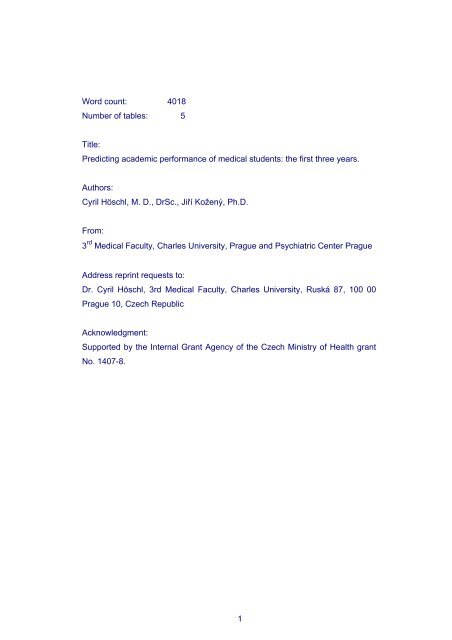

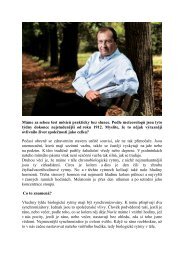
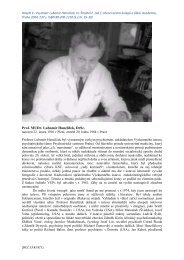
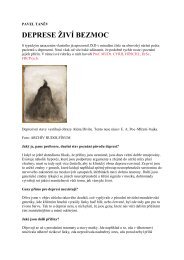
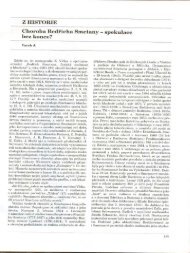
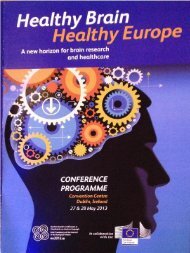

![[s Cyrilem Höschlem vedli Marek Přibil a Lukáš Bek]. Týden 19/2012 ...](https://img.yumpu.com/31823060/1/190x253/s-cyrilem-hoschlem-vedli-marek-pribil-a-lukas-bek-tyden-19-2012-.jpg?quality=85)